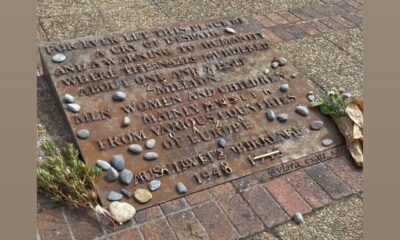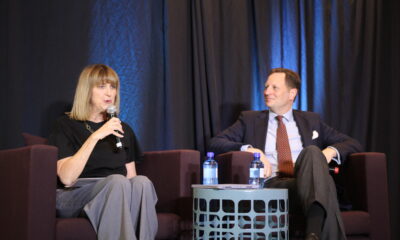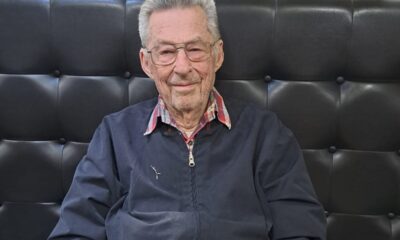
Personal Story

German roots – SA family finds its past
Published
9 months agoon
By
Marc BlochA South African family’s determination to retrace its German ancestors’ steps before the Holocaust has unearthed valuable archival material and introduced never-before-seen family members.
It all started with an invitation back in April 1989 when Hans Schropf, the mayor of a quaint town named Weiden in der Oberpfalz in Bavaria invited Irma Frenkel to return to the place from where, as a young girl, she was forced to flee from the impending devastation.
At the time, Schropf was extending an invitation to all surviving Jews born in Weiden and forced to flee to return to commemorate the 100-year anniversary of the town’s synagogue.
When Irma, sitting in her home in Johannesburg, read the invitation, she dismissed it outright, saying that she would never return to a country that had banished her and killed so many of her relatives and friends.
Her daughter, Marion Bloch, tried to convince her mother to go but, in spite of all attempts, Irma was having none of it. However, the invitation fuelled a deep desire in Bloch to go to Germany to explore her parents’ roots.
After they passed away, this burning desire to discover her history led Bloch to embark on an expedition in April, along with her four children.
The first stop was to a small cemetery in Mertloch, 3.2km from the small village of Polch, in which her father, Max Frenkel, had grown up. The family came from a long line of cattle dealers, affording their eldest son, Max, the opportunity to study at the University of Cologne for a BCom. Thereafter, he worked at the Research Institute for the Retail Trades at Cologne University. This abruptly ended when he was arrested on campus for publicly expressing anti-Hitler sentiments.
On his release, after spending six months in prison, his girlfriend met him at the police station with a packed suitcase and an exhortation from his parents not to return home. They feared for his safety as the SS (Schutzstaffel) had made it known that it was after him again. He fled to Paris and three years later, finding the anti-Jewish climate there untenable, journeyed to South Africa, arriving on 3 October 1936.
The village of Polch had only a small Jewish population before the war. In 1925, there were 59 Jews and 3 000 gentiles. Bloch had done research before her journey to track down where her great-grandparents, Friederich-Wilhelm Anschel and Auguste Anschel, were buried. In an off-the-beaten-track open field, she found the cemetery, with no more than 80 graves.
The family recited a memorial prayer for those buried, probably the first time it had been recited at this location since 1939.
The next stop was the Polch synagogue, built in 1876, which was partially destroyed on 9 November 1938 in the Kristallnacht madness. Fortunately, a large part of the building was salvaged. Several years later, the community helped to restore it and transform it into an exhibition centre. The family felt the very present horrors of that blood-stained night. After praying the afternoon service, the caretaker told the family that prayers hadn’t been heard in that synagogue since 1938.
The family went on to find Max’s childhood home, which was a challenge as they knew the name of the street but not the house number.
Fortunately, Bloch had a faded photograph of her father as a young child, taken in front of the house in which he had grown up. They eventually stumbled upon it. Bloch stood aghast, staring at the exterior of the house that mirrored the image she held in her hand. Apart from a coat of paint, the house hadn’t changed an iota in 84 years!
The house had apparently been sold by Max’s parents in 1939, just before they fled Germany, but the new owners resold it in 1959.
After a quick tour, reluctantly given by the new tenant, they met the only Jew left in Polch, Inge Kahn, a 95-year-old Holocaust survivor who recalled fond memories of some of Bloch’s family. Kahn and her own mother had been taken to Theresienstadt and her father to Auschwitz, but they survived both camps.
The next leg of the journey was a trip 402km east to Weiden, where Irma grew up.
Before the trip, Bloch had spent hours speaking to archivist Dr Sebastian Schott, the mayor of Weiden, and others in preparation. No sooner had the train pulled into the station than the archivist whisked them off to meet the mayor. Walking through the pebbled streets of the old city of this quaint little town, Bloch, together with her children, could only conjecture what life had been like pre-Holocaust and what could have been.
At the cultural office, the archivist handed the family a large folder of documents containing various registration certificates of births and marriages spanning the years 1850 to 1936.
Along with those were photographs of Irma, aunts, uncles, and grandparents whom they were seeing for the first time. These documents had been discovered in the basement below the building, amidst a vast collection of records pertaining to hundreds of Jewish families. On the basis of these records, they assured the family German citizenship, if so desired.
Schott then excitedly ushered the family into a large, adjacent archives room cluttered with files, scanners, and computers. With a boyish grin on his face, he announced that there was yet another surprise.
With that, a video cranked into action on one of the large computer screens. It jumped incessantly, clearly showing signs of age, but the promotional film produced in 1926 to entice people to come live in Weiden showed a vibrant, bustling town, boasting a wide range of shops and beautiful landmarks.
Irma’s father, Victor Katz, ran his successful retail store in the town centre, which was the ground floor of their home. Bloch said she had always tried to imagine what merchandise it sold, when there, before her eyes, a frame of Victor Katz’s shop entrance suddenly popped onto the screen. The family watched agog while this movie took them on a tour inside the shop, bringing the store to life.
The trip ended with the mayor escorting the family to the one and only synagogue in Weiden, the very same one which Irma had attended growing up.
While walking up the steps leading to the main prayer room, one of Bloch’s children spotted a picture on the wall of a young girl that he thought bore an uncanny resemblance to Irma. Upon closer examination, it was indeed a picture of her as Habonim madrich at a camp in 1934.
It’s remarkable that a Jewish community exists there today, living a Jewish life in a place in which 80 years ago, they were killed or forced to flee.
Jewish tradition is steeped in the belief in the transmission of knowledge, values, and heritage from one generation to the next and so, returning home from the trip, the family felt a profound sense of accomplishment at unearthing the many documents that could have been lost to it forever.
- Marc Bloch is the second oldest of Marion Bloch’s four children. He lives in London, England.
- According to Germany-Visa.org, the descendants of this category of people can easily restore their German citizenship, and there they can find the steps towards it.










